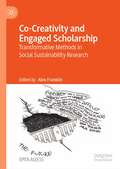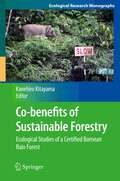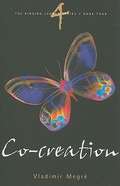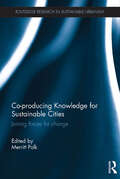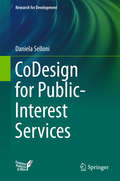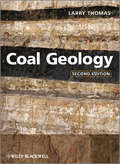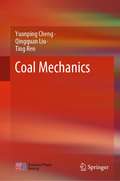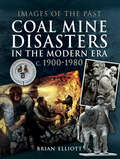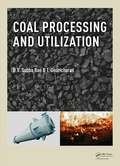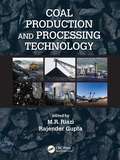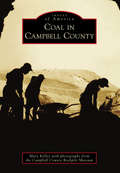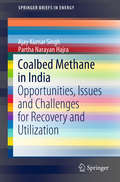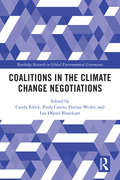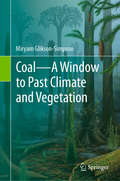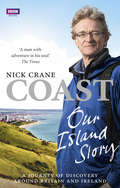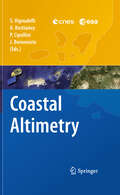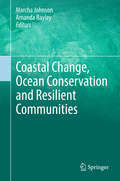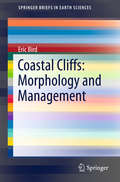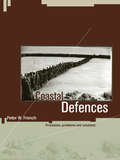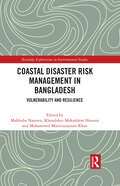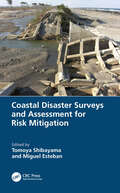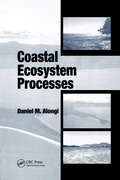- Table View
- List View
Co-Creating with Nature: Healing the Wound of Separation
by Pam Montgomery• Establishes that being in partnership with Nature is our birthright, explores the roots of our separation, and demonstrates that we are designed to communicate with Nature• Offers six principles of co-creative partnership with Nature that serve as a map for guiding us back to our rightful place as a part of Nature• Explains that plants can guide us in living according to our true essential nature and details the steps of creating and facilitating a plant initiation with common plantsWe are in the midst of a global transformation where we must heal our separation from Nature and restore our partnership with the living Earth, which is essential to co-creating a world where all life—human and nonhuman—can thrive.In this groundbreaking book, Nature Evolutionary and Earth Elder Pam Montgomery draws on her decades of working with plants and Nature consciousness to demonstrate that we are intrinsically created to be in relationship with Nature. She examines the co-opting of time, language, and culture to shed light on the roots of our separation, weaving together contemporary research on human physiology with personal experience.She offers six principles of developing a co-creative partnership, explaining that we can communicate with Nature through vibratory resonance. She details the steps of co-creating an initiation with a specific plant ally, where bonding brings healing, and she shares evocative stories, meditations, and the healing wisdom gained from the profound plant initiations she and her students have participated in, all with common plants.Through this book, Pam reveals how to restore our relationship with the living Earth and come home not only to Nature but also to ourselves. She shows that when we nurture ourselves, trust our intuition, and allow for joyful encounters, we restore our interconnection with all life.
Co-Creativity and Engaged Scholarship: Transformative Methods in Social Sustainability Research
by Alex FranklinThis open access book explores creative and collaborative forms of research praxis within the social sustainability sciences. The term co-creativity is used in reference to both individual methods and overarching research approaches. Supported by a series of in-depth examples, the edited collection critically reviews the potential of co-creative research praxis to nurture just and transformative processes of change. Included amongst the individual chapters are first-hand accounts of such as: militant research strategies and guerrilla narrative, decolonial participative approaches, appreciative inquiry and care-ethics, deep-mapping, photo-voice, community-arts, digital participatory mapping, creative workshops and living labs. The collection considers how, through socially inclusive forms of action and reflection, such co-creative methods can be used to stimulate alternative understandings of why and how things are, and how they could be. It provides illustrations of (and problematizes) the use of co-creative methods as overtly disruptive interventions in their own right, and as a means of enriching the transformative potential of transdisciplinary and more traditional forms of social science research inquiry. The positionality of the researcher, together with the emotional and embodied dimensions of engaged scholarship, are threads which run throughout the book. So too does the question of how to communicate sustainability science research in a meaningful way.
Co-benefits of Sustainable Forestry: Ecological Studies of a Certified Bornean Rain Forest (Ecological Research Monographs)
by Kanehiro KitayamaTropical rain forests are increasingly expected to serve for climate change mitigation and biodiversity conservation amid global climate change and increasing human demands for land. Natural production forests that are legally designated to produce timber occur widely in the Southeast Asian tropics. Synergizing timber production, climate change mitigation and biodiversity conservation in such tropical production forests is one of the most realistic means to resolve these contemporary global problems. Next-generation sustainable forest management is being practiced in the natural tropical rain forest of a model site in Sabah, Malaysian Borneo, while earlier sustainable management practices have generally failed, leading to extensive deforestation and forest degradation elsewhere in the tropics. Ecologists have examined co-benefits of sustainable forestry in the model forest in terms of forest regeneration, carbon sequestration and biodiversity in comparison to a forest managed by destructive conventional methods. Taxonomic groups studied have included trees, decomposers, soil microbes, insects and mammals. A wide array of field methods and technology has been used including count plots, sensor cameras, and satellite remote-sensing. This book is a compilation of the results of those thorough ecological investigations and elucidates ecological processes of tropical rain forests after logging. The book furnishes useful information for foresters and conservation NGOs, and it also provides baseline information for biologists and ecologists. A further aim is to examine the environmental effects of a forest certification scheme as the model forest has been certified by the Forest Stewardship Council. Taken as a whole, this book proves that the desired synergy is possible.
Co-creation (The Ringing Cedars Series #4)
by Vladimir Megré John Woodsworth Leonid SharashkinIf you wish to gain as full an appreciation as possible of the ideas, thoughts and images set forth here, as well as experience the benefits that come with this appreciation, we recommend you find a quiet place for your reading where there is the least possible interference from artificial noises (motor traffic, radio, TV, household appliances etc.). Natural sounds, on the other hand -- the singing of birds, for example, or the patter of rain, or the rustle of leaves on nearby trees -- maybe a welcome accompaniment to the reading process.
Co-producing Knowledge for Sustainable Cities: Joining Forces for Change (Routledge Research in Sustainable Urbanism)
by Merritt PolkAt the current time, many issues and problems within sustainable urban development are managed within traditional disciplinary and organizational structures. However, problems such as, climate change, resource constraints, poverty and social tensions all exceed current compartmentalization of policy-making, administration and knowledge production. This book provides a better understanding of how researchers and practitioners together can co-produce knowledge to better contribute to solving the complex challenges of reaching sustainable urban futures. It is written for academic and professional audiences working with urban planning and sustainable cities around the world. Co-producing Knowledge is presented, by way of introduction, as a non-linear, collaborative approach to knowledge production which combines interdisciplinary, transdisciplinary, cross sector and policy approaches to societal problem solving. Examples are taken from Cape Town, Gothenburg, Kisumu, Manchester, Melbourne and a selection of cities in Southeast Asia. Each city chapter discusses the drivers and motivations behind knowledge co-production and gives concrete examples of activities and approaches that have been used to promote sustainable urban futures. Each chapter is written to promote mutual learning from the approaches that are already in use. Building upon these city cases, the conclusions outline an international practice and research agenda aimed at strengthening the promotion and implementation of the knowledge co-production for sustainability across diverse urban development contexts. This book provides an overview of the diverse driving forces behind co-production, and their specific contexts and constraints in a variety of cosmopolitan urban contexts. Some of these include institutional and cross-sector barriers to co-production, the need for learning across diverse levels and contexts, and strategies for balancing scientific excellence with the needs of societal change. This book offers valuable lessons regarding the concrete implications and potential impact that co-production processes can have for different user groups, such as planners, politicians, researchers, business interests and NGOs in different urban development contexts.
CoDesign for Public-Interest Services (Research for Development)
by Daniela SelloniThis books focuses on co-design, and more specifically, on the various forms co-design might take to tackle the most pressing societal challenges, introducing public-interest services as the main application field. To do so, it presents an extensive study conducted within a particular community of residents in Milan: this is a social innovation story integrated into the discipline of service design, which simultaneously deepens the related concepts of co-design, co-production and co-management of services. Drawing upon this experience and further studies, the book presents the idea of a collaborative infrastructure and its related infrastructuring process in ten steps, in order to explore the issues of incubation and replication of services and to extensively investigate the creation of those experimental spaces in which citizen participation is fostered and innovation in the public realm is pursued. Lastly, the book develops other lines of reflection on co-design seen, for example, as a form of cultural activism, as an instrument for building citizenship, and as a key competence for the public administration and thus as a public service itself. The idea of co-design as a way to regenerate the practices of democracy is a recurring theme throughout the book: co-design is a process that seeks to change the state of things and it is intentionally presented as a long and complex path in which the role of designer is not only that of a facilitator, but also that of a cultural operator who contributes with ideas and visions, hopefully fostering a real cultural change.
Coal Geology
by Larry ThomasCoal Geology, second edition, offers a thoroughly revised and updated edition of this popular book which provides a comprehensive overview of the field of coal geology.Coal Geology covers all aspects of coal geology in one volume, bridging the gap between the academic aspects and the practical role of geology in the coal industry. The object of the book is to provide the reader with a with a description of the origins of coal together with the physical and chemical properties of coal and coal petrology before proceeding to cover all areas of coal exploration, production and use. Bridges the gap between academic aspects of coal geology and the practical role of geology in the coal industryExamines historical and stratigraphical geology, together with mining, environmental issues, geophysics and hydrogeology and the marketing of coalDefines worldwide coal resource classifications and methods of calculationAddresses the alternative uses of coal as a source of energy, together with the environmental implications of coal usage Includes improved illustrations including a colour sectionOffers a global approach covering expanding fields in America, China and IndiaThe truly global approach, drawn from the international experiences of the author, recognizes the growing role of coal use in emerging markets. With fully revised coverage of the latest modelling techniques, environmental legislation, equipment and recording methods, the second edition offers a truly invaluable resource for anyone studying, researching or working in the field of coal geology, geotechnical and mining engineering and environmental science.
Coal Mechanics
by Yuanping Cheng Qingquan Liu Ting RenThis book focuses on the mechanical properties and permeability of coal, and the gas flow in coal seams. Based on coal permeability models, it establishes different models for coal seam gas, from the linear flow model to the gas–solid coupling flow model. It also provides the theoretical basis for the exploitation and safe production of coal as well as coal seam gas resources. As such, it is a valuable reference for researchers, advanced students and practitioners working in mining engineering and coalbed methane engineering.
Coal Mine Disasters in the Modern Era c. 1900–1980 (Images of the Past)
by Brian Elliott&“These haunting images, with well-researched facts, figures and timelines providing context, bring the bygone era of 20th-century coal mining to life.&”—Family Tree Although everyday fatalities in mines was far greater, it was the disasters that encouraged those in power to reform the way in which miners had to work underground, especially with regard to safety. And it would be no exaggeration to say that it was the disasters that greatly contributed to bringing the coal industry into national control. Sadly, for bereaved individuals and families, nothing could really compensate for the loss of one or more of a loved one. The impact of the big disasters, where hundreds of men and boys—one or two generations—were lost, immediately, the impact was massive, and continued to be felt many years afterwards. New and restored disaster memorials bear testimony to the great respect that former mining communities continue to have for their &“lost miners.&” Using many previously unpublished images, and a carefully supportive text, the author provides a detailed overview of mining disasters in the modern era, from the early 1900s to the 1980s. It is the first book of its kind to attempt such a large project in pictorial form with a foreword by Ceri Thompson, curator of the Big Pit, the Welsh national mining museum. The book is published at a particularly poignant time, after the recent closure of Britain&’s last deep coal mine. &“So many remarkable photographs and drawings: The story may be tragic, but it is one that lies at the very heart of the history of coal mining in Britain.&”—WDYTYA? magazine
Coal Processing and Utilization
by D.V. Subba Rao T. GouricharanThis book is a direct outgrowth of classes that the authors gave over a period of three decades to a university audience taking a Mineral Beneficiation course as a major that included coal processing and utilization. It is designed to be used as a student's (or layman's) first introduction to coal processing and utilization, motivating the concepts
Coal Production and Processing Technology (Fuels and Petrochemicals)
by M. R. Riazi Rajender GuptaCoal Production and Processing Technology provides uniquely comprehensive coverage of the latest coal technologies used in everything from mining to greenhouse gas mitigation. Featuring contributions from experts in industry and academia, this book:Discusses coal geology, characterization, beneficiation, combustion, coking, gasification, and liquef
Coal in Campbell County (Images of America)
by Mary Kelley Campbell County Rockpile MuseumIn his Annual Report of the Territorial Geologist to the Governor of Wyoming 1890, Louis D. Ricketts wrote, "The coal of this district has little other use than that of supplying a local market." Years later, nothing could be further from the truth. The United States uses approximately one billion tons of coal a year, with about 390 million tons coming from Campbell County, Wyoming. Since large-scale commercial coal production began in Campbell County in the mid-1970s, most coal companies have changed names, owners, and boundaries several times. To let those changes go unrecorded would be to lose the very beginning of coal in Campbell County.
Coalbed Methane in China: Geological Theory and Development
by Yan Song Xinmin Zhang Shaobo LiuThe coalbed methane (CBM) reserve in China ranks third in the world with a total resource of 36.8×1012 m3. Exploitation of CBM has an important practical significance to ensure the long-term rapid development of China natural gas industry. Therefore, in 2002, the Ministry of Science and Technology of China set up a national 973 program to study CBM system and resolve problems of CBM exploration and exploitation in China. All the main research results and new insights from the program are presented in this book. The book is divided into 11 chapters. The first chapter mainly introduces the present situation of CBM exploration and development in China and abroad. Chapters 2 through 9 illustrate the geological theory and prospect evaluation methods. Then chapters 10 and 11 discuss CBM recovery mechanisms and technology. The book systematically describes the origin, storage, accumulation and emission of CBM in China, and also proposes new methods and technologies on resource evaluation, prospect prediction, seismic interpretation and enhanced recovery. The book will appeal to geologists, lecturers and students who are involved in the CBM industry and connected with coal and conventional hydrocarbon resources research.
Coalbed Methane in India: Opportunities, Issues and Challenges for Recovery and Utilization (SpringerBriefs in Energy)
by Ajay Kumar Singh Partha Narayan HajraThis book offers a first-of-its-kind, standalone review of coalbed methane (CBM) in India, covering all the major technical and policy aspects. As an authoritative text on CBM in India, it addresses the essential geological, engineering and policy issues. The Coalbed Methane industry is a rapidly developing sector in Indian energy supply. The book presents the characteristics of coal beds in India's Damodar and Son river valleys, which influence the commercial viability of CBM in the regions, as well as a study of the gas contents of the country's major coalfields. The book begins with a brief review of methane emissions from Indian coal mines and the current coalbed methane situation in the country. Its unique features include a coalfield-by-coalfield technical assessment of CBM throughout India. Policy matters are addressed, including the National Exploration Licencing Policy (NELP) of the Indian Government Ministry of Petroleum and Natural Gas, which is vital to an overall understanding of CBM development in the country. The scope and depth of its book's coverage will benefit students, practising engineers, researchers and policy-makers.
Coalitions in the Climate Change Negotiations (Global Environmental Governance)
by Carola Klöck, Paula Castro, Florian Weiler, and Lau Øfjord BlaxekjærThis edited volume provides both a broad overview of cooperation patterns in the UNFCCC climate change negotiations and an in-depth analysis of specific coalitions and their relations. Over the course of three parts, this book maps out and takes stock of patterns of cooperation in the climate change negotiations since their inception in 1995. In Part I, the authors focus on the evolution of coalitions over time, examining why these emerged and how they function. Part II drills deeper into a set of coalitions, particularly "new" political groups that have emerged in the last rounds of negotiations around the Copenhagen Accord and the Paris Agreement. Finally, Part III explores common themes and open questions in coalition research, and provides a comprehensive overview of coalitions in the climate change negotiations. By taking a broad approach to the study of coalitions in the climate change negotiations, this volume is an essential reference source for researchers, students, and negotiators with an interest in the dynamics of climate negotiations.
Coal—A Window to Past Climate and Vegetation
by Miryam Glikson-SimpsonThis book focuses on the Permian time slice in the geological history of Gondwana, which includes Australia, India, South Africa, Antarctica and South America. Coal is an organic rock, the product of compressed and ‘cooked’ plants. The exact formation of coal via physicochemical reactions, burial and subsidence is the subject of numerous books. The vast thick coal deposits characterising Gondwana formed from special kind of trees termed the Glossopteris Flora. These trees shed their leaves in winter and with the rest of their remains decayed and through subsidence and burial formed the coal. Pollen preserved from these plant communities has been concentrated and isolated and is the focus of this book. The first plant communities as can be seen from the pollen graphs in this book were impoverished in species. The Permian era started with a very cold climate and as the climate warmed more and more diverse vegetation took hold. The emergence of different forms of pollen at certain times in the Permian is used as an indicator of climatic change. Furthermore, the predominance of algal spores in some samples and lack of representation by pollen of Glossopteris point to significant changes in the climate which led to the disappearance of their pollen and the accumulation of spores representing algal communities. These climate induced changes are noticed in their completed transformation after a long time span; small changes are evident during a lifetime of Earth’s inhabitants. Today, in our lifetime, we can see and witness the drying of many lakes across the Earth and their total disappearance from maps of only 50 years ago is a testimony to a climatic change taking place. The time of a ‘complete’ change in the Permian is possible to calculate. However, to determine the duration and maximum change in the climate of the earth today is impossible due to the apparent acceleration of the process by industrial activities of our species. Chapter 4 in the book deals with the special characteristics of the Permian coals of Gondwana and the special plant community which made them. The composition of these coals on a microscopic level shows them to be rich in hydrocarbons, more than other coals. The Permian coals of India and Australia generate ‘heavy’ oil which is retained within the coal matrix as bitumen and is a potential source of methane. This chapter demonstrates through a pilot study the potential for explosion in the Permian Gondwana coals through their propensity to spontaneous combustion and methane generation.
Coast: A Journey of Discovery Around Britain's Coastline
by Nicholas CraneAlong our shores, towering cliffs from the age of the dinosaurs rise beside wide estuaries teeming with wildlife, while Victorian ports share waterfronts with imposing fortifications.And the people who have lived, worked and played on this spectacular coast - from Stone Age fishermen to seafarers, chart-makers and surfers - have an incredible tale to tell.Coast: Our Island Story is an enthralling account, sparkling with geography, history, adventure and eccentric characters, told with Nick Crane's trademark charisma and wit.
Coastal Altimetry
by Andrey G. Kostianoy Jérôme Benveniste Paolo Cipollini Stefano VignudelliThe book describes experience in application of coastal altimetry to different parts of the World Ocean. It presents the principal problems related to the altimetry derived products in coastal regions of the ocean and ways of their improvement. This publication is based on numerous satellite and observational data collected and analyzed by the authors of the various chapters in the framework of a set of international projects, performed in UK, France, Italy, Denmark, Russia, USA, Mexico and India. The book will contribute both to the ongoing International Altimeter Service effort and to the building of a sustained coastal observing system in the perspective of GMES (Global Monitoring for Environment and Security) and GEOSS (Global Earth Observation System of Systems) initiatives. This book is aimed at specialists concerned with research in the various fields of satellite altimetry, remote sensing, and coastal physical oceanography. The book will be also interesting for lecturers, students and post-graduate students.
Coastal Change, Ocean Conservation and Resilient Communities
by Amanda Bayley Marcha JohnsonThis collection of essays and design case studies explores a range of ideas and best practices for adapting to dynamic waterfront conditions while incorporating nature conservation in urbanized coastal areas. The editors have curated a selection of works contributed by leading practitioners in the fields of coastal science, community resilience, habitat restoration, sustainable landscape architecture and floodplain management. By highlighting ocean-friendly innovations and strategies being applied in coastal cities today, this book illustrates ways to cohabit with many other species who share the waterfront with us, feed in salt marshes, bury their eggs on sandy beaches, fly south over cities along the Atlantic Flyway, or attach themselves to an oyster reef. This book responds to the need for inventive, practical, and straightforward ways to weather a changing climate while being responsible shoreline stewards.
Coastal Cliffs: Morphology and Management (SpringerBriefs in Earth Sciences)
by Eric BirdThis book offers an insight into the global occurrence, geomorphology, evolution, weathering and erosion of coastal cliffs and bluffs. Stabilization and preservation of cliffs are treated in detail. Mitigation of cliff hazards and preservation of scenic features and sites of scientific importance requires effective coastal cliff management that can only be based on thorough knowledge of the physical processes at work. Cliffs have been cut in various geological formations, and have taken shape as a sequel to a world-wide sea level rise. Most cliffs have receded as the result of weathering and erosion, but some are now stable. Where they are actively receding, consuming useful agricultural or forested land or threatening coastal structures such as roads, buildings and seaside towns, it may be necessary to halt their retreat, or at least to modify it, by coastal cliff management.
Coastal Conservation
by Brooke Maslo Julie L. LockwoodCoastal ecosystems are centres of high biological productivity, but their conservation is often threatened by numerous and complex environmental factors. Citing examples from the major littoral habitats worldwide, such as sandy beaches, salt marshes and mangrove swamps, this text characterises the biodiversity of coastline environments and highlights important aspects of their maintenance and preservation, aided by the analysis of key representative species. Leaders in the field provide reviews of the foremost threats to coastal networks, including the effects of climate change, invasive species and major pollution incidents such as oil spills. Further discussion underscores the intricacies of measuring and managing coastline species in the field, taking into account the difficulties in quantifying biodiversity loss due to indirect cascading effects and trophic skew. Synthesising the current state of species richness with present and projected environmental pressures, the book ultimately establishes a research agenda for implementing and improving conservation practices moving forward.
Coastal Defences: Processes, Problems and Solutions
by Peter W. FrenchCoastal Defences aims to present the broad spectrum of methods that engineers use to protect the coastline and investigates the sorts of issues that can arise as a result. The first section of the book examines 'traditional' hard techniques, such as sea walls and groynes, whilst the second looks at the more recent trend of using techniques more sympathetic to nature. By looking at each of the main methods of coastal protection in detail, the book investigates the rationale for using each method and the consequent management issues, presenting a case for and against each of the techniques.
Coastal Disaster Risk Management in Bangladesh: Vulnerability and Resilience (Routledge Explorations in Environmental Studies)
by Mohammed Moniruzzaman Khan Mahbuba Nasreen Khondoker Mokaddem HossainThis book addresses disaster and disaster risk reduction (DRR) practices, constraints and capacity in the context of coastal Bangladesh. Located in the lower riparian of the Bay of Bengal, Bangladesh has to face frequent disasters such as floods, cyclones, river erosion, salinity intrusion as well as drought. Drawing together a range of multidisciplinary perspectives, Coastal Disaster Risk Management in Bangladesh explores the connection between climate change and DRR issues in this region. The editors reorganize disaster studies around social and physical changes that can reduce these risks and put at risk populations on a stronger footing by making risk reduction the focus. These include measures to improve disaster preparedness, to boost recovery by creating better disaster planning and programs, and physical and social initiatives to improve disaster resilience. Also, analyzing the gender perspective, the volume also utilizes the local knowledge framework to consider whether these populations have resilient knowledge that needs to be incorporated into initiatives based on advanced technology and perspectives. This book will be of interest to academics, researchers, students, policymakers and practitioners in the field of disaster, DRR and governance, climate change, climate change adaptation (CCA) and the environment.
Coastal Disaster Surveys and Assessment for Risk Mitigation
by Miguel Esteban Tomoya ShibayamaThis collection covers essential concepts in the management of coastal disasters, outlining several field surveys of such events that have taken place in the 21st century, including the Indian Ocean Tsunami, the Tohoku Earthquake and Tsunami, and the storm surges generated by Hurricane Katrina, Cyclone Nargis, and Typhoon Haiyan. Measurements of flood heights, distributions of structural destruction, and the testimonies of residents are reported, with the results being analysed and compared with past events and numerical simulations to clarify and reconstruct the reality of these disasters. The book covers the state-of-the-art understanding of disaster mechanisms and the most advanced tools for the simulation of future events: • Uniquely explains how to use disaster surveys along with simulations to mitigate risk • Combines pure scientific studies with practical research and proposes procedures for effective coastal disaster mitigation Coastal Disaster Surveys and Assessment for Risk Mitigation is ideal for students in the field of disaster risk management, as well as engineers who deal with issues related to tsunamis, storm surges, high wave attack and coastal erosion.
Coastal Ecosystem Processes
by Daniel M. AlongiCoastal Ecosystem Processes, written by the renowned marine scientist Daniel Alongi, describes how pelagic and benthic food webs, from beaches and tidal flats to the continental edge, process energy and matter. This volume focuses on recent advances and new developments on how food webs are closely intertwined with the geology, chemistry, and physics of coastal seas. Dr. Alongi presents a process-functional approach as a way of understanding how the energetics of coastal ecosystems rely not only on exchanges within and between food chains, but how such functions are influenced by terrigenous and atmospheric processes. There is a need for documentation and an awareness of just how necessary, yet delicate, is the interplay of biological and physical forces between coastal ocean, land, and the atmosphere. Marine scientists today need to make informed management decisions about sustainable development and conservation of these fragile ecosystems. Coastal Ecosystem Processes provides present and future marine scientists the latest coastal ecosystem information to make the right decisions concerning the ecology of our oceans.

